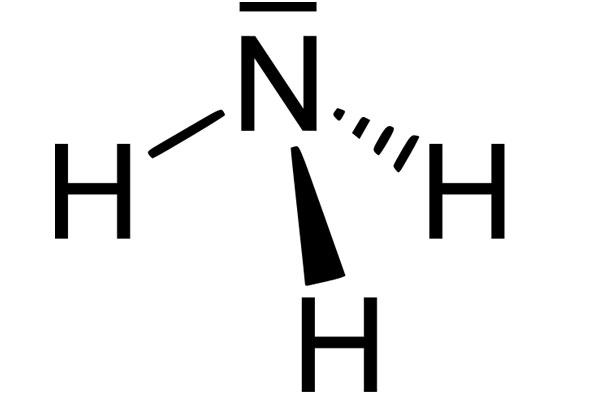Cas No: 1336-21-6
EINESC No: 215-647-6
Molecular weight: 17.031 gr/mol
Chemical Formula: C7H8
Chemical Structure:
Physical Properties
General Properties: Colorless gas(usually sold as aquatic solvent)
Odor: Strong, disturbing
Intensity: 0,00073 g/cm3
Boiling point: -33.34 °C
Melting point: −77.73 °C
Flash point: 132 ° C
Vapor pressure: 857,3 kPa
Refraction index: 1,3327 nD
Solubility (aqueous): miscible in every amounts

General Properties
Ammonia is a colorless, inorganic chemical that is found in gas form. It is the most commonly used chemical in industry and it is toxic for humans. It is usually sold in aqueous solution form as its gas form is hard to work with and it easily dissolves in water due to polar structure that it possesses. It has a very sharp and disturbing odor. One of the most characteristic property of it is that it does not contain hydroxyl functional group in its pure from and it still is a weak alcali.
Although it is formed metabolically in beings, it is immediately dropped out because of its hazardous nature.
Production
Ammonia is industrially produced via Haber-Bosch method. In this method, nitrogen and hydrogen are put into reaction. Generally, nitrogen is aquired from air and hydrogen is acquired from natural gas. Although the reaction is exothermic, it has low effiiency. If it is taken into consideration that there are 175 billions of tons of ammonia is produced per year, ammonia production costs 1% of global energy usage due to the high cost of extracting nitrogen from air.
Also, ammonia causes corrosion on metals, therefore, the equipments used in this process are constantly changed. This increases the total cost even more.
Applications
Ammonia is almost used in every part of the industry as it is one of the most fundamental alcali. It is mostly used in agriculture. It is a very good fertilizer as a nitrogen source and even in its pure form, it is commonly used in this field.
Another field that ammonia is commonly used is production of nitrogen based compounds. Ammonia is the raw material of almost every nitrogen based compounds as it can be put into reaction fairly easily.
Its ability to provide a radiant cleaning without leaving trace makes ammonia highly preferred in cleaning business. It is commonly used, both domestic and industrially, for cleaning glass, china and metal. In low concentrations, ammonia is also used as nitrogen source for bacteria for speeding up fermentation process. In high concentrations, it is used as antiseptic to extend shelf life.
When in pure form and in normal temperature, it is easily liquefied via pressure and it has high heat of evaporation. Therefore, it is used as cooling agent in industry. Although chlorofluorocarbon compounds once took its throne, it has regained it after the damage dealt to ozone layer by these compounds is calculated. Its high toxicity and its effect on metals make ammonia hard to use in this field.
Ammonia is commonly used in textile business, as well. It is used in certain rockets as fuel. It is also used as nitrogen source in expolive making.
Aside from these, it is used in many fields in industry, in low doses.
Safety Measures and Toxic Values
Ammonia solutions does not pose a threat in humans and other mammals unless it is in high concentrations. However, it is hazardous to fish. Therefore, ammonia is extremely dangerous to underwater life and even the smallest doses may be fatal to fish.
Ammonia is also extremely irritant for skin and it may cause serious burns. It may cause problems in internal organs if it is inhaled. If it contacts with eyes, it may cause permanent vision disfunctions.
It is also abrasive for metals and it is flammable in high temperatures. Therefore, it must be stored in cool and well-aired environments.